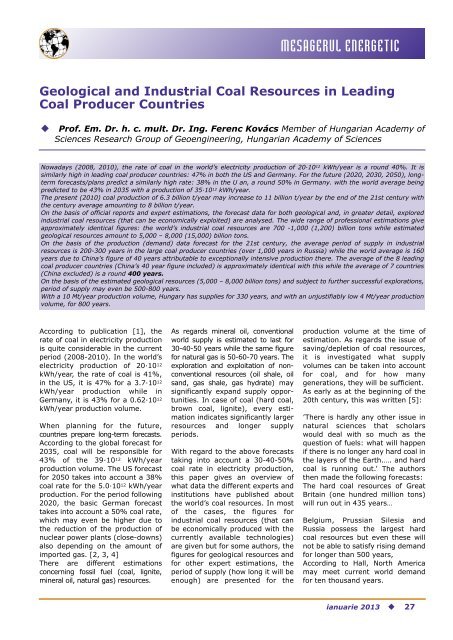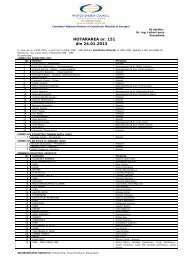Create successful ePaper yourself
Turn your PDF publications into a flip-book with our unique Google optimized e-Paper software.
M E S A G E R U L E N E R G E T I C<br />
Geological and Industrial Coal Resources in Leading<br />
Coal Producer Countries<br />
<br />
Prof. Em. Dr. h. c. mult. Dr. Ing. Ferenc Kovács Member of Hungar<strong>ian</strong> Academy of<br />
Sciences Research Group of Geoengineering, Hungar<strong>ian</strong> Academy of Sciences<br />
Nowadays (2008, 2010), the rate of coal in the world’s electricity production of 20·10 12 kWh/year is a round 40%. It is<br />
similarly high in leading coal producer countries: 47% in both the US and Germany. For the future (2020, 2030, 2050), longterm<br />
forecasts/plans predict a similarly high rate: 38% in the U an, a round 50% in Germany. with the world average being<br />
predicted to be 43% in 2035 with a production of 35·10 12 kWh/year.<br />
The present (2010) coal production of 6.3 billion t/year may increase to 11 billion t/year by the end of the 21st century with<br />
the century average amounting to 8 billion t/year.<br />
On the basis of official reports and expert estimations, the forecast data for both geological and, in greater detail, explored<br />
industrial coal resources (that can be economically exploited) are analysed. The wide range of professional estimations give<br />
approximately identical figures: the world’s industrial coal resources are 700 -1,000 (1,200) billion tons while estimated<br />
geological resources amount to 5,000 – 8,000 (15,000) billion tons.<br />
On the basis of the production (demand) data forecast for the 21st century, the average period of supply in industrial<br />
resources is 200-300 years in the large coal producer countries (over 1,000 years in Russia) while the world average is 160<br />
years due to China’s figure of 40 years attributable to exceptionally intensive production there. The average of the 8 leading<br />
coal producer countries (China’s 40 year figure included) is approxi mately identical with this while the average of 7 countries<br />
(China excluded) is a round 400 years.<br />
On the basis of the estimated geological resources (5,000 – 8,000 billion tons) and subject to further successful explorations,<br />
period of supply may even be 500-800 years.<br />
With a 10 Mt/year production volu<strong>me</strong>, Hungary has supplies for 330 years, and with an unjustifiably low 4 Mt/year production<br />
volu<strong>me</strong>, for 800 years.<br />
According to publication [1], the<br />
rate of coal in electricity production<br />
is quite considerable in the current<br />
period (2008-2010). In the world’s<br />
electricity production of 20·10 12<br />
kWh/year, the rate of coal is 41%,<br />
in the US, it is 47% for a 3.7·10 12<br />
kWh/year production while in<br />
Germany, it is 43% for a 0.62·10 12<br />
kWh/year production volu<strong>me</strong>.<br />
When planning for the future,<br />
countries prepare long-term forecasts.<br />
According to the global forecast for<br />
2035, coal will be responsible for<br />
43% of the 39·10 12 kWh/year<br />
production volu<strong>me</strong>. The US forecast<br />
for 2050 takes into account a 38%<br />
coal rate for the 5.0·10 12 kWh/year<br />
production. For the period following<br />
2020, the basic German forecast<br />
takes into account a 50% coal rate,<br />
which may even be higher due to<br />
the reduction of the production of<br />
nuclear power plants (close-downs)<br />
also depending on the amount of<br />
imported gas. [2, 3, 4]<br />
There are different estimations<br />
concerning fossil fuel (coal, lignite,<br />
mineral oil, natural gas) resources.<br />
As regards mineral oil, conventional<br />
world supply is estimated to last for<br />
30-40-50 years while the sa<strong>me</strong> figure<br />
for natural gas is 50-60-70 years. The<br />
exploration and exploitation of nonconventional<br />
resources (oil shale, oil<br />
sand, gas shale, gas hydrate) may<br />
significantly expand supply oppor -<br />
tunities. In case of coal (hard coal,<br />
brown coal, lignite), every esti -<br />
mation indicates significantly larger<br />
resources and longer supply<br />
periods.<br />
With regard to the above forecasts<br />
taking into account a 30-40-50%<br />
coal rate in electricity production,<br />
this paper gives an overview of<br />
what data the different experts and<br />
institutions have published about<br />
the world’s coal resources. In most<br />
of the cases, the figures for<br />
industrial coal resources (that can<br />
be economically produced with the<br />
currently available technologies)<br />
are given but for so<strong>me</strong> authors, the<br />
figures for geological resources and<br />
for other expert estimations, the<br />
period of supply (how long it will be<br />
enough) are presented for the<br />
production volu<strong>me</strong> at the ti<strong>me</strong> of<br />
estimation. As regards the issue of<br />
saving/depletion of coal resources,<br />
it is investigated what supply<br />
volu<strong>me</strong>s can be taken into account<br />
for coal, and for how many<br />
generations, they will be sufficient.<br />
As early as at the beginning of the<br />
20th century, this was written [5]:<br />
’There is hardly any other issue in<br />
natural sciences that scholars<br />
would deal with so much as the<br />
question of fuels: what will happen<br />
if there is no longer any hard coal in<br />
the layers of the Earth.…. and hard<br />
coal is running out.’ The authors<br />
then made the following forecasts:<br />
The hard coal resources of Great<br />
Britain (one hundred million tons)<br />
will run out in 435 years…<br />
Belgium, Pruss<strong>ian</strong> Silesia and<br />
Russia possess the largest hard<br />
coal resources but even these will<br />
not be able to satisfy rising demand<br />
for longer than 500 years,<br />
According to Hall, North A<strong>me</strong>rica<br />
may <strong>me</strong>et current world demand<br />
for ten thousand years.<br />
<strong>ian</strong>uarie 2013 27

















